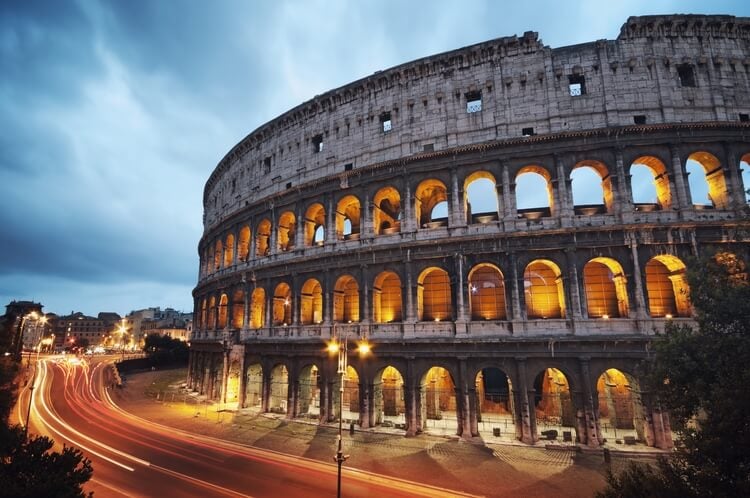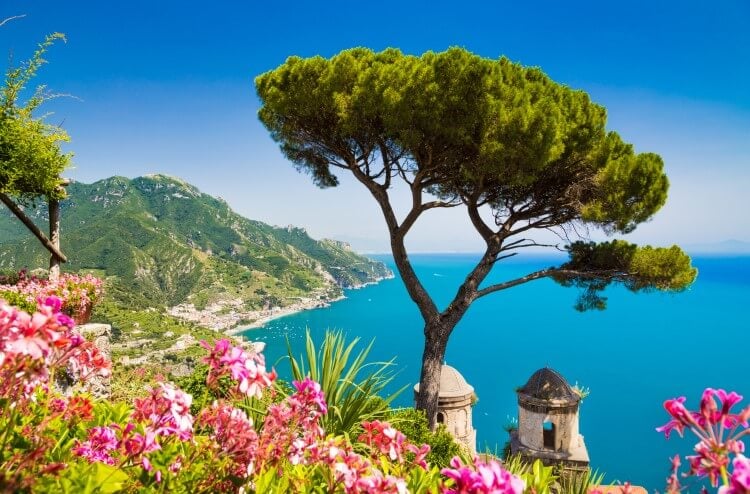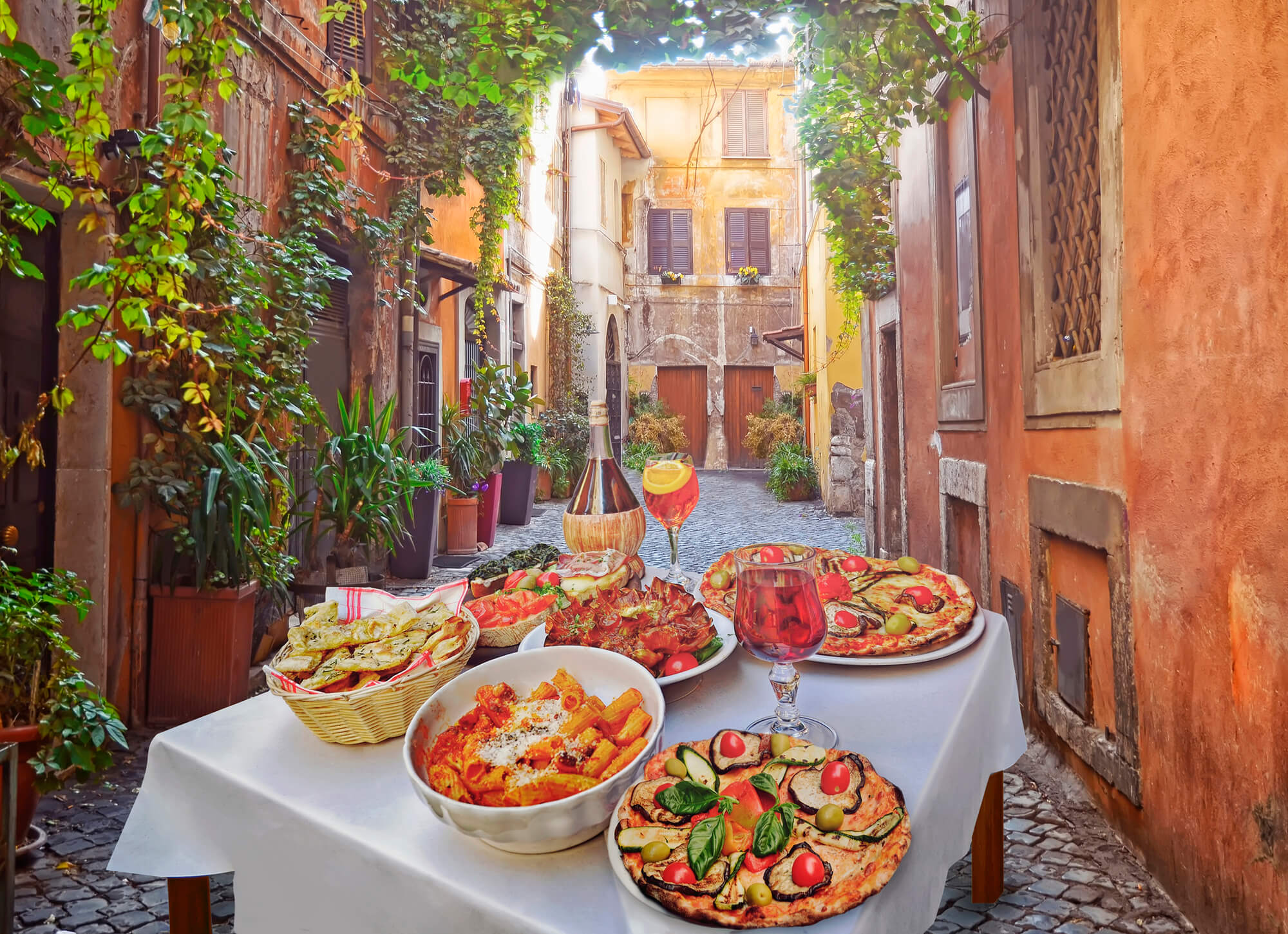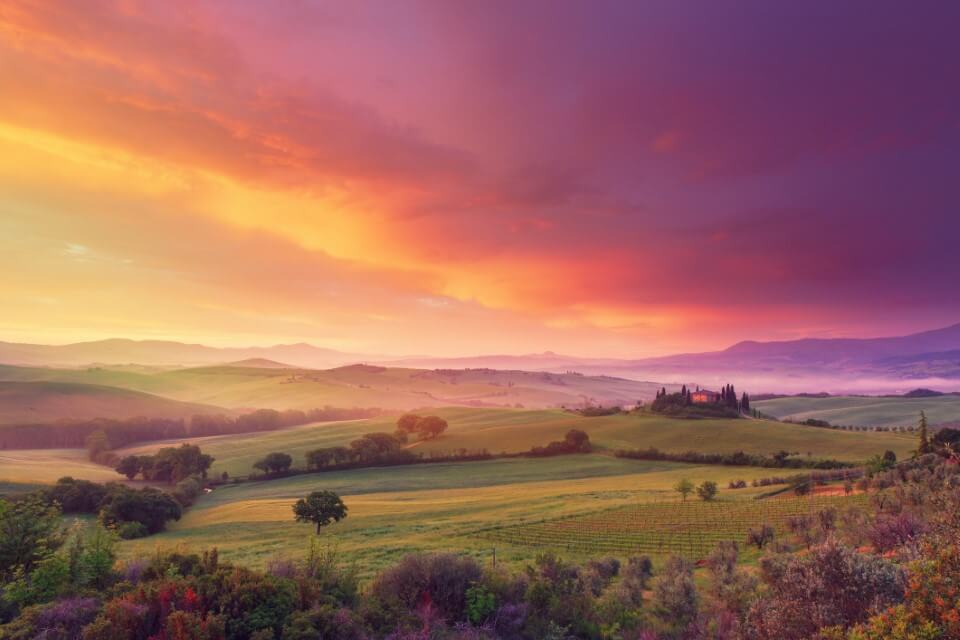Italy is one of the most widely visited countries in Europe. The iconic “boot-shaped’ country boasts thousands of miles of beautiful Mediterranean coastline, vibrant cities, charming towns, breath-taking landscapes, and an incredible history stretching back thousands of years.
That history is one of the reasons why you could spend years exploring the country and never run out of things to do. With ancient ruins abound, medieval hilltop towns, and a once-thriving Renaissance culture that has since left massive footprints on the most popular cities, Italy offers iconic, instantly recognizable landmarks scattered throughout. So how do you even know where to start when it comes to exploring Italian landmarks? Where are they? Why are they famous?
This comprehensive guide will give you everything you need to know about the most famous landmarks in Italy, so you know what to add to your bucket list next, and can impress your friends and family with your knowledge as you explore.
The Colosseum in Rome
Everybody has heard of the Colosseum. Arguably one of the most iconic landmarks in Europe, topping the charts with the Eiffel Tower in Paris, the Colosseum is an ancient structure dripping with blood-thirsty history. At the time of its building, the Colosseum was the largest amphitheater ever built, used for a whole host of activities and performances, many that ended in death. Today, it is still the largest Roman amphitheater in the world, and is excellently preserved so you can visit this incredible slice of ancient culture for yourself.
History of the Colosseum
How old is the Colosseum?
Construction of the Colosseum is estimated to have begun somewhere between 72 AD and 70 AD whilst Vespasian was Emperor, with the construction itself taking around a decade to complete. That means this iconic structure is nearly two thousand years old, which is quite unbelievable considering the condition of the Colosseum. It has truly withstood the test of time, despite experiencing neglect and earthquakes in its long history.
Why was the Colosseum built?
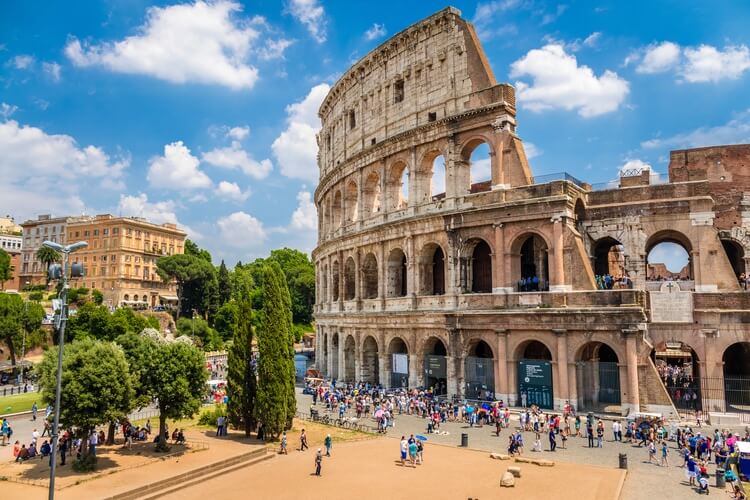
Primarily, the Colosseum was built for entertainment purposes for the people of Rome, and for those who travel further afield to explore the city. At the height of the Colosseum’s condition, it could hold around 50,000 spectators, who would gather to watch gladiators fight, and other combat performances such as with wild animals. Imagine that – 50,000 people roaring and cheering as two warriors fought to the death, simply for their entertainment! It’s baffling to think of in this day and age, but nonetheless, was very popular at the time. In fact, when the Colosseum first opened, the Emperor, then Emperor Titus, threw celebrations in the form of gladiatorial combat for one hundred days straight.
When no hand-to-hand combat was on the schedule, the Colosseum was also used for dramatic performances, and was even once flooded in order to perform a mock naval battle with ships included!
Who fought in the Colosseum?
The people who fought in the Colosseum were known as gladiators. Despite the depictions of gladiators in some modern contexts, most were not refined warriors seeking glory, though some Emperors were known to jump into combat every now and then, like Emperor Commodus. Mostly, gladiators were criminals, slaves, or citizens with large debt they couldn’t pay back, who were all forced to fight for their freedom. If they survived for long enough, typically several years, they could be set free to live a normal life at the end of it, with any crimes written off. Some gladiators excelled and became renowned for their achievements in the Colosseum, such as Spartucus and Crixus.
Shockingly, wild animals were also often used for combat in the Colosseum. In fact, the Colosseum is renowned for being responsible for the extinction of several species of wild animals across the Roman empire.
The Colosseum today
How tall is the Colosseum?
At the time of its construction, the Colosseum was fully oval, and the highest level you can see today once wrapped around the entirety of the structure. That means it once stood at four stories high, and its tallest point is 57 meters high.
How has the Colosseum been preserved over time?
The Roman’s interest in bloodthirsty games and combat didn’t last forever. Eventually, the Colosseum fell into disuse when the Western Roman Empire began to collapse. The Colosseum was abandoned, and slowly deteriorated. Ravaged by earthquakes, and even torn apart in some areas for building materials, the Colosseum faced mighty damage over an extended period of time.
In fact, by the 1900’s, approximately only a third of the original building was still standing. It is pure luck that this portion of the Colosseum withstood the test of time for us modern day folks to witness – a testament to its incredible architecture.
These days, the Colosseum has been completely restored and made safe for visiting, with a mammoth restoration project that began in the early 90’s ensuring the Colosseum will remain standing for centuries more to come.
The Colosseum underground
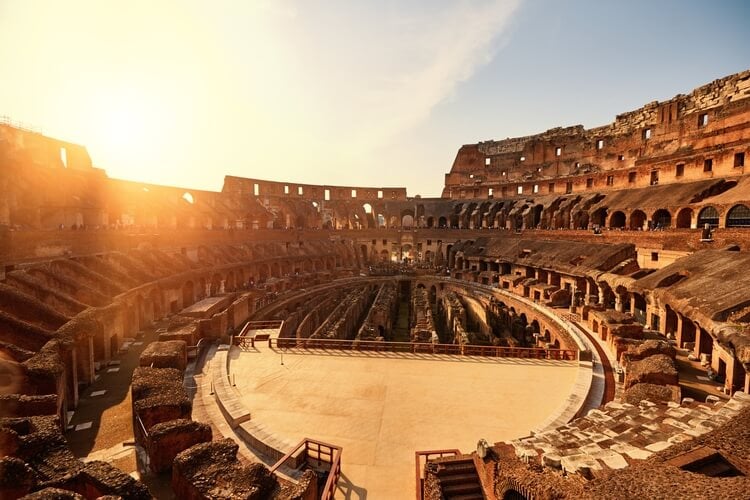
If you are paying a visit to the Colosseum, it really is an unforgettable experience, and should be at the top of everybody’s bucket lists. The history here almost seems alive, like the building thrums with its own heart beat.
If you want to go beyond the typical visit to the Colosseum, you can book onto an underground tour, where you can explore the shadowy recesses where gladiators were once kept as they awaited their battle.
How to get to the Colosseum?
The Colosseum is located in the thriving city of Rome, which sits close to the West coast of Italy, around the middle of the boot shape. The Colosseum is located in the heart of the city, close to the Roman Forum and Palatine hill.
The best way to get to the Colosseum is by using the city’s extensive Metro network. The metro stop “Colosseo”, is the closest to the historical landmark, offering direct access. If you fancy a little walk in order to watch the Colosseum come into view, to really indulge in the momentous experience of seeing it for the very first time, you can get off at Circo Massimo, which is close to the site of an ancient chariot-racing stadium, or Manzoni.
There are also several tram and bus stops located within moments of the Colosseum, so make sure to look up the schedules and routes beforehand if you would like to travel this way.
Sistine Chapel in Vatican City
Where is the Sistine Chapel located?
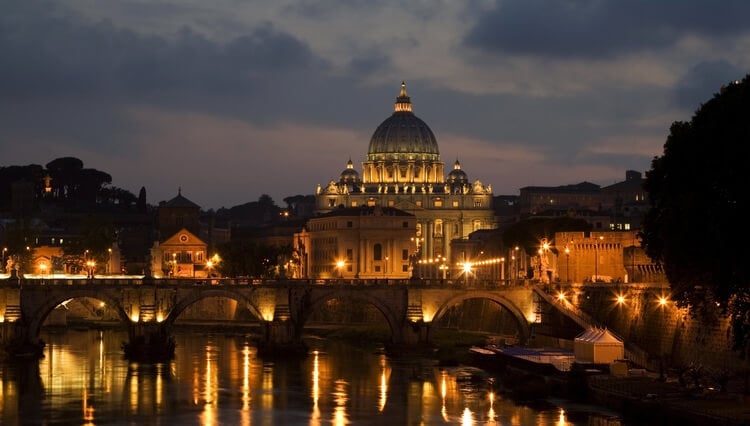
The Vatican City is quite an unusual destination, in that it is its own country, located within the city of Rome. It is famous for being the home to the Pope, and for being the smallest country in the world.
In Vatican City, the streets are opulent and grand, leading to the incredible St Peter’s Basilica, and home to some stunning museums, architecture, artifacts and artwork, including the iconic Sistine Chapel.
Located in the Apostolic Palace, when you get to the Sistine Chapel, remember to look up – for the ceiling is why thousands travel all over the world to visit.
When was the Sistine Chapel built?
The Sistine Chapel itself was built between 1473 and 1481, commissioned by the then Pope Sixtus IV, from whom the chapel gets its name. The chapel was erected to be used for momentous occasions, such as the inauguration of each new Pope as the years go on. Although the building itself is of incredible historical importance, the reason why so many flock here is to view the incredible painting that adorns the ceiling.
Who painted the Sistine Chapel?
Michelangelo was the artist commissioned to fill the ceiling with incredible artwork, of which stands as the reason for many peoples’ visit to the Sistine Chapel, and why it has become such an iconic landmark in Italy.
Michelangelo is one of the most renowned Renaissance minds, working as a sculptor, painter and architect throughout his lifetime, as well as being an accomplished poet. He was born in Florence and made a name for himself as Leonardo da Vinci’s biggest rival in terms of accomplishments and incredible creations.
How long did it take to paint the Sistine Chapel?
Michelangelo’s work on the Sistine Chapel took him just over four years. He started in July of 1508, and completed around 343 figures by the time he finished in October 1512, along with the help from a few trusted assistants.
How did Michelangelo paint the Sistine Chapel?
To paint the ceiling, Michelangelo designed and built a mammoth scaffold structure, from which he and his assistants could work. There is a myth that he painted the ceiling on his back, whilst suspended, but that has since been debunked.
In terms of his painting style, he first used a strange mix of sand and lime over wet plaster, a technique you may have heard when researching the Sistine Chapel called a ‘fresco’ technique. Michelangelo and his assistants would then paint over this mixture while it was still wet, which meant the plaster and the paint fused together permanently as it dried. It is this method that means the Sistine Chapel is still vibrant and in perfect condition today, for you to visit and witness.
The paintings truly come alive off the ceiling, with an unmatched depth to the colors and design the end result of the fresco technique.
What is the most famous scene in the Sistine Chapel?
Here, as part of the varied collection of scenes that make up the awe-inspiring Sistine Ceiling, you will find the world-renowned “The Creation of Adam” scene, where the fingertips of Adam and the humanized depiction of God almost touch. It is considered one of the most important works of Renaissance art in European history, and often emulated throughout European culture in a range of creative mediums, including art and film.

He also depicted other famous scenes from Genesis, and furthermore, created the soaring work known as “The Last Judgment” on the Sistine Chapel’s altar wall.
Sistine Chapel Restoration
In recent history, the Sistine Chapel has undergone a significant restoration to ensure this important landmark’s health, and that it remains in good condition so that visitors centuries from now can also enjoy this incredible piece of European history.
Over a period of fourteen years beginning in 1980 and reaching completion in 1994, professional art restorers delicately and carefully cleaned the artwork and reattached the frescos. The result of which also brought out never before noticed details, and improved the vibrant and incredible palette of colors to more closely resemble what it might have looked like at its conception, which means today, the experience of visiting the Sistine Chapel is that much more incredible.
The Leaning Tower of Pisa
What is the Leaning Tower of Pisa?
The Leaning Tower of Pisa is simply the bell tower for the Pisa Cathedral, located only steps away in beautiful grounds. It was built in the final stages of the construction of the cathedral complex. It is a circular bell tower that stands freely away from the rest of the cathedral, with a bell-chamber at the top that can hold seven bells. If you go to the Leaning Tower of Pisa, you may even hear them ring.
Why does the Leaning Tower of Pisa lean?
Not long after the Leaning Tower was built, it was discovered that the foundations upon which it was constructed were actually uneven. That means in the 1170’s, it was already obvious that it was leaning to one side when only three out of the eight stories of the tower were built. However, the building only continued, which increased the angle of the leaning, and by the 1990’s the angle of the leaning was at 5.5 degrees. However, some restoration work in the last three decades have reduced the tilt, and ensured the tower can remain standing for many years to come.
When was the Leaning Tower of Pisa built?
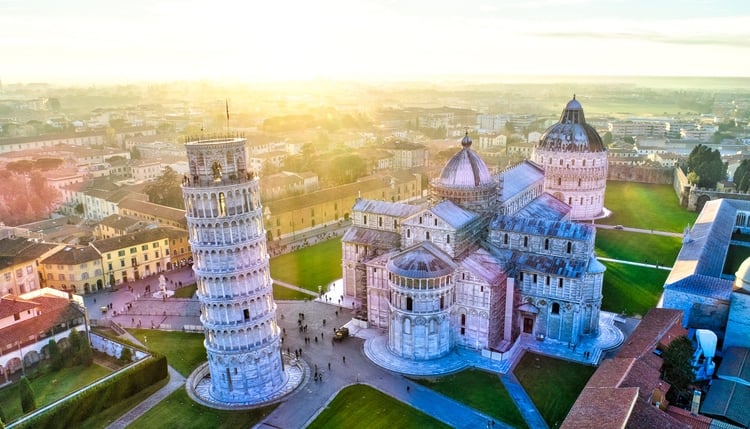
Construction on the Leaning Tower of Pisa began in 1173, and it is estimated that it took almost 200 years to bring to completion. Only five years into its construction did the tower begin tilting – but they continued to build despite that!
Where is the Leaning Tower of Pisa?
Pisa is actually a place in Italy, of which the Leaning Tower is named after, located around the knee-area of the boot-shaped country.
Pisa is located in the Tuscany region, around an hour and twenty minute drive from the region’s capital of Florence towards the East, and with the coast a short twenty minute journey to the West. Pisa itself is a historic city that dates back as far as the 8th century BC, and having lived several lifetimes, such as a Roman colony once known as Pisae.
How tall is the Leaning Tower of Pisa?
The Leaning Tower of Pisa stands at fifty seven meters tall. If it were straight, it would stand at about sixty meters, although due to the tilt, that is not the case.
What’s inside the Leaning Tower of Pisa?
Contrary to popular belief, the Leaning Tower of Pisa is actually more or less completely hollow. Whilst the outside of the tower seems to imply levels, with its beautifully designed marble columns and rings, there is little more than a smooth wall on the interior, with a structure to allow a select few to access the bell chamber at the top.
However, it is possible to visit the viewing platform at the very top of the Leaning Tower of Pisa, where you can stay for around half an hour to take in the view.
Is the Leaning Tower of Pisa safe?
Generally speaking, yes, it is safe to visit the Leaning Tower of Pisa. Thanks to the recent restoration work, architects expect the tower to remain upright (or as upright as it can get) for plenty of years to come. So for now, do enjoy your visit to the Leaning Tower, and make sure you get your iconic photo of attempting to push it back upright!
When will the Leaning Tower of Pisa fall?
Since its restoration and the tilt of the tower having been reduced by a few degrees, the architects who worked on the Leaning of Tower of Pisa have estimated that it will stand as it is for at least another two hundred years. So you have plenty of time to visit this iconic landmark, though your great, great, great (etc) grandchild may not be able to.
However, this doesn’t take into account any other factors such as earthquakes or any future restoration works that might take place.
The Grand Canal of Venice
Where exactly is the Grand Canal?
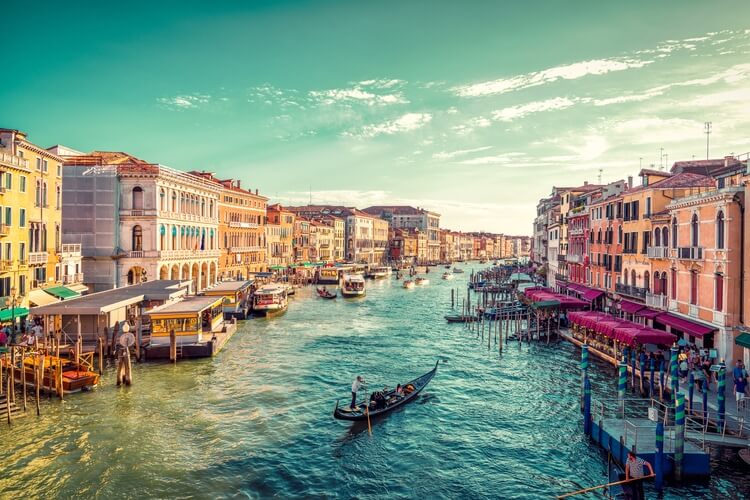
The Grand Canal is located in incredible Venice, the city on the water. Venice is renowned for streets of shimmering water, with a lattice of canals intersecting the entire quaint destination, teeming with boats and intersected by beautiful bridges.
The most beautiful and breathtaking of all the canals in Venice, however, is easily the Grand Canal. Also the largest of the canals, it intersects the entire city from East to West in an “S” shape, offering a wide open space of whispering water that laps against the banks. At its mouth to the West side of the canal, the beautiful Basilica di Santa Maria della Salute, an iconic domed church built in the baroque style in 1687.
The winding Grand Canal effectively cuts the floating city of Venice in half, to its North and South sections, with the Piazza san Marco on its North side, and Basilica S.Maria Gloriosa dei Frari on its South side. You could easily wile away an afternoon exploring everything the banks of the Grand Canal has to offer, as well as the lazy boats slipping through the water as the sun goes down and the lights of Venice illuminate the canal in shimmering ribbons of orange.
The history of the Grand Canal in Venice
The buildings that line the banks of the Grand Canal are some of the most beautiful. Between the 13th century and 18th century, upper-class families would often commission the brightest and best architects of their ages to build awe inspiring residences that would demonstrate their seemingly endless wealth. Therefore, along the banks of the Grand Canal the buildings are often more beautiful than the last, also giving Venice its rich cultural heritage the limelight. Here, you will find palaces besides palaces, rich, almost pearlescent-white facades, and architecture of the Venetian Gothic, Baroque, Renaissance, and even Venetian-Byzantine period following the elegant curve of the canal.
When the Venetian Republic fell in 1797, the competition between Ventian’s wealthiest families to build the most beautiful palaces and homes drew to a close, as finances came under strain. Since then, many of the palaces’ exteriors have been preserved to look exactly how they did back then, but over the last few hundred years, have mostly been converted into public and practical establishments, such as hotels, and often museums.
Milan Cathedral
Milan Cathedral in Italy is one of the most recognizable cathedrals in the entire world, let alone the country. Absolutely dominating the square upon which it sits on, the Piazza Duomo, the Milan Cathedral is the seat of the Archbishop of Milan. The city itself is located in Italy’s Lombardy region, which is located towards the North of the boot-shape, close to the popular destination of Lake Como.
This iconic Italian landmark is well worth a visit simply to soak in the impressive exterior, and the ambience of the surrounding area that basks in the Cathedral’s shadow. At the time of its construction, it was clearly of essential importance to the Italian people, as the surrounding roads either encircle it, or lead away from it, placing it as the very heart of the city, and the focal point of Milan’s character.
How long did it take to build Milan Cathedral?
The time it took to build Milan Cathedral is quite extraordinary. The Cathedral was started back in 1386, and it wasn’t considered completely finished until quite recently – only 1965. That means the building of Milan Cathedral took around six centuries! The architects who conceptualized this fascinating building would have been long gone before they saw their efforts come to fruition.
Similarly, elsewhere in Europe, the Familia Sagrada, a cathedral in Barcelona, Spain, started in 1882 and is not projected to be finished until 2026. Still – this is but a patch on the length of time it took to build Milan Cathedral!
How old is Milan Cathedral?
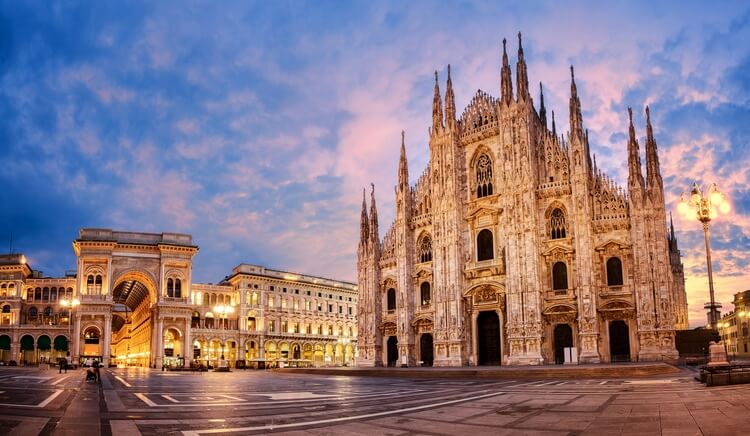
As construction began in the year 1386, from its start, the Milan Cathedral is nearly 650 years old. However, as construction didn’t finish until very recently, in the 20th century, the Cathedral has only been completed for just under 60 years, which is quite baffling!
Who built the Milan Cathedral?
The Milan Cathedral was built over a period of 600 years, meaning it changed hand many times over the course of the centuries. The original architect was Simone da Orsinege, who worked alongside other talented minds to help the vision come to fruition. The architecture of Milan Cathedral is in a Gothic Renaissance style, obvious from the incredible spires that seem to pierce the very sky above it. Overall, the image of Milan Cathedral is rather imposing, as if it has been lifted straight out of a gothic novel.
If you want to really be able to appreciate the incredible exterior design of Milan Cathedral, for a fee, you can even visit the roof, where you can take in the full majesty of the soaring spires.
Milan Cathedral dress code
As is the case with most Cathedrals you will visit on a trip to Italy, and more widely across Europe, dress should be modest. As this is a religious site, respect must be considered as you choose what to wear. For example, thighs and shoulders must be covered, so consider long trousers or skirts, and tshirts. You are also not allowed to wear strappy shoes such as sandals, or anything on your head such as sunglasses and hats, although religious or cultural dress such as hijabs and turbans are acceptable.
How to get to Milan Cathedral
Milan Cathedral is very centrally located within the city, with easy transport links as a major tourist attraction. In fact, the Cathedral has its own dedicated Metro stop called Duomo, which means “Italian Cathedral”. So take full advantage of the straightforward metro system to reach the beautiful Milan Cathedral.
If you would like to get a bus or tram, however, there are plenty of stops located within close walking distance, so be sure to check schedules and routes ahead of time, as well as the walking route between them.
Pompeii
Pompeii ruins
Everybody has heard the story of Pompeii. A once thriving city nestled in the shadow of the foreboding Vesuvius, gone in an instant, a blink of the eye. In 79 AD, so just under 2000 years ago, Mount Vesuvius erupted, burying the Roman city under lies of ash and other volcanic matter, freezing the unfortunate inhabitants’ bodies for the rest of time.
Not only did the volcanic ash kill and preserve the Pompeii people and any other living thing that had the misfortune to be in Pompeii at the time, but it also fell upon and preserved the infrastructure and architecture of the ancient city. Walls still stand, buildings still stand, leaving behind a perfect imprint of the city it once had been.
Did anyone in Pompeii survive?
Anybody who came into contact with the volcanic matter, unfortunately, would not have stood a chance. All in all, the volcanic ash and gasses that erupted, likely killed everyone in the city within about fifteen minutes from the start of the eruption. Simply put, if somebody decided to remain within the city at the time, survival was simply not possible.
With that being said, the population of Pompeii before the eruption was around 20,000, and experts have estimated that around 2000 people died due to the eruption. The Pompeii survivors had left the city in good time with help from the Roman navy, or on their own when the first warning signs began. Before the eruption, earthquakes likely occurred, prompting many to leave before disaster struck.
Was Pompeii a wealthy city?
Yes, Pompeii was a wealthy town that put much attention into building beautiful structures, including soaring public buildings and lavish private residences for Pompeii’s most wealthy citizens. In fact, Pompeii was something of a playground for rich Romans to build incredible second (or third properties), in which they could relax and unwind amongst beautiful, sumptuous surroundings. Excavators have found much evidence of these luxury lodgings, including fine furniture, and even artwork,
How was Pompeii discovered?

The disaster in Pompeii occurred in 79 AD, and the city was not discovered again until surveying engineer, Domenico Fontana, found Pompeii in the 16th century. It was by complete chance that the ruins were found, and excavation soon began to unearth the buried city.
Where is Pompeii in Italy?
The ancient city of Pompeii is located very close to the vibrant city of Naples which sits on the other side of the foreboding Mount Vesuvius, of which was responsible for the decimation of Pompeii. On a wider scale, Pompeii is located on the West coast of Italy, down towards the ankle-area of the country’s “boot shape”. Nearby you will also find the popular destination of Sorrento, and the Amalfi coast.
Can you visit Pompeii?
Yes, Pompeii is an extraordinary tourist destination, and an absolutely unmissable site to visit to experience a terrible event in history. You can walk about the ancient city ruins on your own, and explore the still-standing structures freely. You can also view the casts taken of some of Vesuvius’s victims, with around 100 located at the site in the modern day.
How long do you need to tour Pompeii?
If you are exploring Pompeii without a guide, you can get a good sense of the city in around 3-4 hours. However, as there is so much to do and the main sites are often located quite far apart, a visit to Pompeii could fill an entire day. It is up to you how long you spend, and if you want to absorb all the details and information you possibly can and really take your time, or explore only parts of the city.
Royal Palace of Caserta
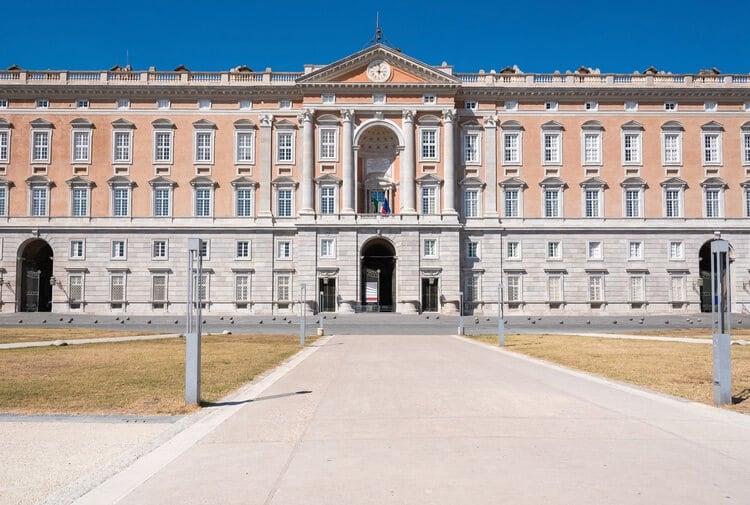
The Royal Palace of Caserta, also known as the Palazzo Reale di Caserta, truly is a sight to behold. Although it is not often the main historic landmark in Italy people think of when they consider the top priority bucket list sites in the country, the Royal Palace of Caserta is simply unmissable if you want to view some of the iconic opulence of Italy from the 1700’s. The beautiful palace, now a UNESCO World Heritage site, occupies an incredible 47,000 meters squared of land. Before you even get to the palace itself, expect tree-lined walkways, beautiful water features including whispering fountains, and extensive gardens for you to explore, of which are considered amongst the finest in Europe.
The Royal Palace of Caserta itself was built in a late Baroque and early Neoclassical architectural style, offering an imposing, dominating facade. With 1200 rooms inside the sprawling palace, a visit here will be more than enough to fill your day with incredible, sumptuous interiors, and an insight into how the wealthy of Italy once lived.
History of the Royal Palace of Caserta
The Royal Palace of Caserta was originally built beginning 1752, as a decadent and quite unbelievably luxurious residence for Charles III of Spain, who was eventually crowned the king of Two Sicilies and once ruled Southern Italy and Sicily between the 18th and 19th centuries. At the time of the Royal Palace of Caserta’s construction it was the largest palace built in Europe throughout the entirety of the 18th century, and remains, to this day, the largest royal residence ever built in the world. Nothing has ever been able to top it in terms of size, and arguably, in architectural wonder.
So there you have it. We hope you have enjoyed our comprehensive guide to the most famous landmarks in Italy, and have learnt some fascinating facts about these iconic structures, so you can wow your friends and family when you visit.
If you’re in the throes of planning your vacation, make sure you check out our guide to planning a trip to Europe. and our guide to The Best Time To Visit Italy. And don’t forget to book your luxury accommodation so you can vacation in style. Our properties are hand-chosen, located in fabulous destinations around the world and fully-equipped with everything you need for a perfect stay. Browse through our vacation villas in Italy now.

